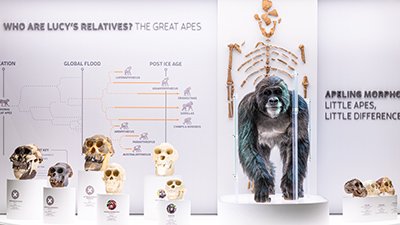
Lunatics, Lucy, and a Little Nook for the School Library
A review of Making Friends with Fossils: How to Find Your Way Through the Maze of Human Origins by Helen Lawrence.
The Australian Skeptics have donated copies of Helen Lawrence’s booklet, Making Friends with Fossils: How to Find Your Way Through the Maze of Human Origins, to schools across Australia.
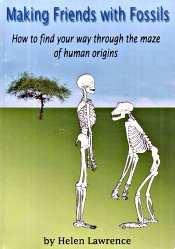
Book cover: Making Friends with Fossils
Subsequently published in TJ 18(3):35–40, 2004.
In their ongoing enmity to the true biblical understanding of our origins, the Australian Skeptics have donated copies of Helen Lawrence’s booklet, Making Friends with Fossils: How to find your way through the maze of human origins, to schools across Australia. This easy-to-read and engaging “science” book is aimed at undermining a biblical worldview and indoctrinating children into the belief that we are a cosmic accident of evolution; a chance rearrangement of organic molecules, with no purpose and no meaning. In penning the foreword, Colin Groves notes: “It is important for us to know where we came from and how we got here and that we are not so special … yet there is so much misunderstanding about human evolution that it is all too easy for the lunatic fringe to bend the evidence and mislead the unwary [emphasis added].”1 The seeds of disbelief in the divine Creator are being purposely sown in our schools from the youngest ages in the name of “science”.
Unbiased Seekers of the Truth?
In the introduction, Making Friends espouses the idea that “… the people who pursue the chase for knowledge in this field [evolutionists] are after just one thing—to find out the truth.” This position is contrasted with those “who ignore the underlying knowledge”. However, this strawman contrast of the unbiased truth seeker that “knows” the “true” evolutionary story with the biased, ignorant creationist who rejects it comes unstuck when one reads the words of archaeologist Donald Johanson, the discoverer of Lucy (Australopithecus afarensis—the subject of chapter 1). Johanson is not aware of these mythical “unbiased truth seekers”:
“There is no such thing as a total lack of bias. I have it; everybody has it. The fossil hunter in the field has it. … In everybody who is looking for hominids, there is a strong urge to learn more about where the human line started. If you are working back at around three million, as I was, that is very seductive, because you begin to get an idea that that is where Homo did start. You begin straining your eyes to find Homo traits in fossils of that age. … Logical, maybe, but also biased. I was trying to jam evidence of dates into a pattern that would support conclusions about fossils which, on closer inspection, the fossils themselves would not sustain [emphasis added].”2
Johanson went on to confess: “It is hard for me now to admit how tangled in that thicket I was. But the insidious thing about bias is that it does make one deaf to the cries of other evidence.”3
Lawrence, herself, is not afraid to do a bit of evolutionary imagining about the central character of chapter 1: “Lucy must have fed on entrails and got blood and guts all over her until she had a dip in the lake [p. 5].” An amazing story, but what is the evidence that this is the “truth”?
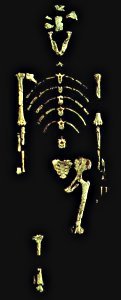
Layout of the fossil remains representing “Lucy”. Evidence from the pelvis, rib cage, arms, wrist and inner ear all indicate not a missing link but something less similar to both humans and chimpanzees, than these latter are to each other.
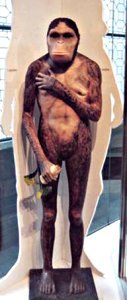
Museum displays of “Lucy” are misleading. Note the hands and feet, which look very human, while the actual bones, as shown above, were not found. Bones from other Australopithecus specimens indicate a knuckle-walking ape.
Lucy’s Pelvis and Hender
Lawrence asks the important question of how Lucy’s discoverers knew she was female, and informs us that her (Lawrence’s) qualifications in obstetrics and gynaecology have helped her “to appreciate birth mechanisms”. From the diminutive size of the pelvis, Donald Johanson and others interpreted Lucy (fossil designation AL 288–1) as being a female.4 But as Hausler and Schmid discovered: “The sacrum and the auricular region of the ilium are shattered into numerous small fragments, such that the original form is difficult to elucidate. Hence, it is not surprising that the reconstructions by Lovejoy and Schmid show marked differences.”5
In regard to Lucy’s pelvis, Johanson affirmed: “Lucy’s wider sacrum and shallower pelvis gave her a smaller, kidney-shaped birth canal, compared to that of modern females. She didn’t need a large one because her newborn infant’s brain wouldn’t have been any larger than a chimpanzee infant’s brain.”6 That admission begs the question as to why this fossil was not categorized within the chimp family. But this gender declaration poses additional problems for Lucy. As Hausler and Schmid noted: “If AL 288–1 was female, then one can exclude this species from the ancestors of Homo because its pelvis is certainly less primitive than the pelvis of Sts 14 [designation for a specific Australopithecus africanus fossil that is supposedly a descendant from Lucy, emphasis added].”7 Both of the pelvises mentioned displayed some degree of damage, and both were missing critical parts. However, it should be noted that, in regard to the Lucy fossil, more than one attempt was made at reconstruction.
The reconstructions of the inlet and midplane of Lucy’s pelvis, and comparisons to other fossils and modern humans, reveals that the shape of Lucy’s pelvis was not structured correctly to give birth. The pelvis was just too narrow to accommodate an australopithecine fetus. Hausler and Schmid noted that Lucy’s pelvis was ridgeless and heart-shaped, which means that “she” was more likely a “he”. They noted:
“Contrary to Sts 14, delivery in AL 288–1 would have been more complicated than in modern humans, if not impossible, due to the protruding promontorium …. Consequently, there is more evidence to suggest that AL 288–1 was male rather than female. A female of the same species as AL 288–1 would have had a pelvis with a larger sagittal diameter and a less protruding sacral promontorium … . Overall, the broader pelvis and the more laterally oriented iliac blades of AL 288–1 would produce more favourable insertion sites for the climbing muscles in more heavily built males … with such a pelvis, “Lucy” would apparently have been the last of her species [emphasis added].”8
This declaration has received an enormous reaction from the evolutionist community, as many scientists work diligently to defend Lucy. If Hausler and Schmid’s conclusion is correct, then the equivalent female of this species would have been even smaller—something unheard of in trying to compare this creature to modern humans! Lucy’s pelvis is not what it should be for an upright-walking hominid—but the dimensions do fall within primates found among the ape family. Why was this scientific truth ignored?
Lucy’s Rib Cage
Due to the impossibility of reconstructing Lucy’s skull from the few fragments available, the determination that Lucy walked upright (like a human) had to be derived from her hips and ribs. Peter Schmid, a paleontologist at the Anthropological Institute in Zurich, Switzerland, studied Lucy for quite some time, and summarized his efforts as follows:
“When I started to put the skeleton together, I expected it to look human. Everyone had talked about Lucy as being very modern, very human, so I was surprised by what I saw. I noticed that the ribs were more round in cross-section, more like what you see in apes. Human ribs are flatter in cross-section. But the shape of the rib cage itself was the biggest surprise of all. The human rib cage is barrel shaped, and I just couldn’t get Lucy’s ribs to fit this kind of shape. But I could get them to make a conical shaped rib cage, like what you see in apes.”9
It is true that ribs can be “tweaked” and rotated so that they appear more barrel-like or conical, but the best (and correct) arrangement will always be the original morphology. The facets from the ribs that line up on the vertebrae provide a tighter fit when aligned correctly. In Lucy’s case, its ribs were conical, like those found in apes.
Lucy—Walking, or Swinging from the Trees?
What do Lucy’s arms and legs tell us in regard to its locomotion? Making Friends tells us that Lucy “had long arms like a tree-clinging ape” (p. 4). If Lucy were a biped, surely her upper and lower extremities would indicate an upright stance. Yet the bony framework that composes Lucy’s wrists may be the most telling of all. Brian Richmond and David Strait of George Washington University in Washington, D.C., experienced what many might call a “Eureka!” moment while going through some old papers on primate physiology at the Smithsonian Institution.
“We saw something that talked about special knuckle walking adaptations in modern African apes”, Dr Richmond said. “I could not remember ever seeing anything about wrists in fossil hominids. … Across the hall was a cast of the famous fossil Lucy. We ran across and looked at it and bingo, it was clear as night and day.”10 Lawrence is aware of the anatomy of chimps wrists, “A chimp has a less flexible wrist, held habitually in a knuckle walking position, flexed with the arm pronated (back of arm facing forwards). A wrist needs a stiffer structure when it is used for taking weight in that position … [p. 22].” However Lucy is never mentioned in this discussion.
Richmond and Strait discovered that knuckle-walking apes have a mechanism that locks the wrist into place in order to stabilize this joint. In their report, they noted: “Here we present evidence that fossils attributed to Australopithecus anamensis (KNM-ER-20419) and A. afarensis (AL 288–1) retain specialized wrist morphology associated with knuckle-walking.”11
Not only have Lucy’s wrists and arm bones been called into question, but there is also a mountain of evidence that demonstrates this fossil was better adapted for swinging through trees, like modern-day chimps. Lawrence was correct; Lucy’s arms were long, “like a tree-climbing ape”. So the natural question to ask is: Why was Lucy not considered just that?
Australopithecine Ears—Did Lucy Walk Uprightly?
Knowing that primary bipedalism is unique to humans, Fred Spoor and colleagues decided to evaluate the vestibular apparatus of the inner ear—an area designed to help coordinate body movements. Modern human locomotor activity requires that the vestibular apparatus of the inner ear be able to maintain body posture, even though we are constantly balancing all of our weight on very small areas of support. Anyone who has suffered vertigo knows firsthand just how crucial this area is for balance and everyday activities. Using high-resolution computer tomography, Spoor et al. were able to generate cross-sectional images of the bony labyrinth that comprised the inner ear. They wrote: “Among the fossil hominids, the earliest species to demonstrate the modern human morphology is Homo erectus. In contrast, the semicircular canal dimensions in crania from southern Africa attributed to Australopithecus and Paranthropus resemble those of the extant great apes.”12 With that single declaration, Spoor and his colleagues have drawn a line which unequivocally states that all fossils prior to Homo erectus have ape-like morphology that allowed them to climb trees, swing from branches, or walk hunched over on their knuckles. Toward the end of her booklet, Lawrence observed: “As I understand it there is one major gap. This lies between the australopithecines and habilines [p. 62].” Spoor’s work shows the “truth” that evolution has no evidence of a link between these groups.
Lucy—Hominid or Chimp?
When Lucy first arrived on the scene, news magazines such as Time and National Geographic noted that she had a head shaped like an ape, with a brain capacity the size of a large chimp’s—about one-third the size of a modern human’s. Adrienne Zihlman remarked: “Lucy’s fossil remains match up remarkably well with the bones of a pygmy chimp.”13 It should be no surprise then, that in Stern and Susman’s analysis of A. afarensis, they pointed out: “These findings of ours … all seem to lead ineluctably to the conclusion that the Hadar hominid [Lucy] was vitally dependent on the trees for protection and/or sustenance.”14
All of these facts point toward the truth that Lucy was simply an ape-like creature.
Evolutionist, Professor Charles Oxnard of the University of Western Australia used objective “un-biased” computerized multivariate analysis of many measurements on australopithecine bones.15 He (and an increasing number of other researchers who are not associated with the discovery of any of these creatures) found that all of the australopithecines, grouped together anatomically, are further away from both apes and humans than these two groups are from each other. They conclude that the australopithecines were a unique group of extinct creatures, not anatomically intermediate between apes and humans, so were not evolutionary “links” at all.
All of these facts point toward the truth that Lucy was simply an ape-like creature. Sadly, Making Friends ignores this truth in favour of evolution.
The “Truth” or Evolutionary Story-Telling?
Throughout the book, Lawrence weaves a tale of vast spans of time. In chapter two, she even works in an ancient age for the earth—making sure students are fully indoctrinated with evolutionary ages. She notes: “These proto-humans were dotted about the landscape for the immense time period of two million years, although this is nothing compared to the age of the earth at four and a half billion [p. 10, emphasis in original]!” Yet she never once mentions how often evolutionists have changed the dates for human evolution, and how it continues, even today, to be pushed back farther as additional time is needed to explain current findings.
In further distinguishing our alleged ancestors, Lawrence mentioned Sir Arthur Keith, an anatomist who set the brain volume marker for humans at 750 cubic centimetres (p. 11). Since Lawrence placed Ian Tattersall’s Human Evolutionary Tree on the back cover, one would expect her to be familiar with Tattersall’s observation regarding brain size:
“… as it turns out, the concept of a gradual increase in brain size over the eons is actually rather problematic. For a start, this idea strongly implies that every ounce of extra brain matter is equivalent in intelligence production to every other brain ounce—which is clearly not the case [emphasis added].”16
No evidence exists that demonstrates a relationship between brain size and intelligence within any given species. The human brain, for example, is known to range in volume from less than 1,000 cubic centimetres to more than 2,000. In fact, some of the most intelligent people in history had small brains, while Neanderthals, who are normally characterized by evolutionists as being of low intelligence, allegedly had larger brains.
Yet evolutionists routinely classify hominid fossils largely according to brain size.17 The assumption is, of course, that the human brain started out in early primates as a relatively small, insignificant organ, and then evolved through time to the size it is now. But why should this be the case? That is the very question Stephen Jay Gould asked in the concluding chapter of his volume Ever Since Darwin:
“But why did such a large brain evolve in a group of small, primitive, tree-dwelling mammals, more similar to rats and shrews than to mammals conventionally judged as more advanced? And with this provocative query I end, for we simply do not know the answer to one of the most important questions we can ask [emphasis added].”18
I assume this “truth” was not one of those mentioned in the introduction. Lawrence continued, noting: “Once a hominin could balance in the fully upright position, the mechanical advantage it gave them was apparently grabbed and used for its efficiency [p. 14].” But just seven pages later, she speaks of OH 62, who had “many of the attributes of a habiline, and yet, judging by those long arms, she appeared to have gone back to getting a living in the trees” (p. 21). Why? How is such baseless evolutionary story-telling classified as “knowledge’?
Toward the end of the second chapter, Making Friends makes several telling comments, given the pledge for truth and knowledge. In the section titled “Did australopithecines make tools?”, it is noted: “The australopithecines must have used stones and digging sticks, but so far no worked stone tools have been found directly in association with them [p. 15, italics in original, bold emphasis added].” Translation: “Our theory predicts this to be true. And while we haven’t found any evidence to support it, we know it must be true.” And further: “We can only speculate on whether a female had a particular male to offer her food in exchange for exclusive sexual rights [p. 16].” Speculate indeed! Is this science (from the Latin scientia, meaning “knowledge’) or psychic fortune-telling?
Java Man
In chapter four, Making Friends introduces two individuals who, history has recorded, had skeletons in their closets: Ernst Haeckel and Eugene Dubois (p. 26). According to Lawrence, the zoologist Haeckel (infamous for his faked drawing of embyros used to support evolution)19 “had a hunch” that inspired an “untrained, but enthusiastic” Dubois to set out looking for another “missing link”. Later, in 1890, Dubois, now trained as an anatomist, focused his attention on the banks of the Solo River, near the village of Trinil in Indonesia. Excavators discovered a human-like fossilized tooth in September 1891. One month later, they uncovered the upper part of a skull. A year later, the team discovered a thighbone in the same sandstone layers, about fifteen metres upstream. In additional excavations, the team did not discover anything else except one tooth. As it turns out, the leg bone and teeth were, in fact, human. Lawrence admits that Dubois hid fossils under the floorboards of his house, but she blamed it on “pique” (wounded vanity). What she does not tell school children is that below those floorboards were also other skulls—modern-looking skulls—that were found in the same level of strata, and would have surely put an end to Dubois” precious Java man. For more information, see Who was ‘Java Man’?
Neanderthal Man—Distant Cousin or Merely Human?
In her chapter on “Neanderthal Life”, Lawrence continues her imaginative speculations, telling school children that the Neanderthal nose, being unusually large and prominent was “a climate-prompted mutation. It was an air-warming defrosting device [p. 38, emphasis added].” Certainly natural selection can differentiate on existing mutations, but how does climate prompt a mutation? Are the discredited ideas of Lamark part of this “underlying knowledge’?

Neanderthal skull (F1413S Gibraltar Skull): photo by David Green. Neanderthals’ features fall within the range of those of modern humans.
Lawrence goes on to discuss the studies which compared mitochondrial DNA (mtDNA—which resides in the cell’s mitochondria, or “energy factories’) from humans with mtDNA extracted from a Neanderthal specimen.20 Krings et al. suggested that fewer differences in the mtDNA exist between modern humans than exist between modern humans and the Neanderthal specimen. Based on those differences, evolutionists have suggested that the Neanderthal line diverged from the line leading to modern humans about 550,000 to 690,000 years ago, and that Neanderthals became extinct without contributing any genetic material to modern humans through intermarriage. Much evolutionary mileage has been made of this suggestion,21 but what was the actual data? The Krings study compared various DNA sequences from 1,669 modern humans with one Neanderthal. Statistically, this is not only insignificant, but also misleading. As Lubenow wrote concerning this mtDNA research:
“Statistics has [sic] been used to cloud the relationship between Neanderthals and modern humans. It is improper to use statistical “averages” in situations where many entities are being compared with only one entity. In this case, 994 sequences from 1,669 modern humans are compared with one sequence from one Neanderthal. Thus, there is no Neanderthal “average”, and the comparison is not valid [emphasis added].”22
The original study showed that the Neanderthal individual had a minimum of 22 mtDNA substitution differences when compared to modern humans. Yet mtDNA substitution differences among modern humans range from 1 to 24. As Lubenow correctly noted:
“That means that there are a few modern humans who differ by 24 substitutions from a few other modern humans—two substitutions more than the Neanderthal individual. Would not logic demand that those few modern humans living today should also be placed in a separate species? To state the question is to reveal the absurdity of using such differences as a measure of species distinctions.”23
Furthermore, as Maryellen Ruvolo of Harvard has pointed out, the genetic variation between the modern and Neanderthal sequences is within the range of substitutions within other single species of primates. She concluded: “… there isn’t a yardstick for genetic difference upon which you can define a species.”24 Geneticist Simon Easteal of Australian National University, noting that chimpanzees, gorillas and other primates have much more intra species mtDNA diversity than modern humans, wrote: “The amount of diversity between Neanderthals and living humans is not exceptional.”25
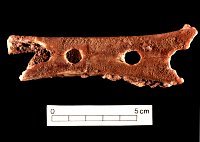
Neanderthal flute: photo by Marko Zaplatil. This piece of hollowed bone from a Neanderthal archaeological site is believed to be part of a flute with the hole spacing conforming to the diatonic (do, re, mi …) musical scale.
Over the past several years, the scientific community has witnessed (not always to its liking, I might add) a serious “redefining” of the Neanderthal people. Some anthropologists of the past depicted them as culturally stagnant, if not outright stupid, individuals. In 1996, however, researchers were forced to re-evaluate their long-held views on Neanderthals, due to the discovery of musical instruments and items of personal ornamentation (similar to our jewelry).26,27,28 Furthermore, almost all anthropologists recognize burial rituals as a human trait and a distinctly religious act. That being the case, the strongest evidence that the Neanderthals were, in fact, human, is that at four different sites where Neanderthal fossils were found, Neanderthals and modern humans were buried together! “That Neanderthals and anatomically modern humans were buried together constitutes strong evidence that they lived together, worked together, intermarried and were accepted as members of the same family, clan and community. … If genuine mtDNA was recovered from the fossil from the Neander Valley, the results have been misinterpreted.”29 Archaeologist Randall White, of New York University, said, regarding the Neanderthals: “The more this kind of evidence accumulates, the more they look like us.”30 Indeed they do, supporting the idea that they are a group of people descended from Noah.
It should also be pointed out that the method used to determine the dating of the separation of modern humans and Neanderthals is based on evolutionary assumptions about the fossil record to calibrate the “mutational”, or “molecular”, clock.31 Thus, Lawrence’s reasoning is not “underlying knowledge” but circular, self-reinforcing propaganda.
Mitochondrial DNA—Lawrence Hasn’t Read the Obituary
Chapter eight discusses “migratory/mitochondrial Eve”. Unfortunately for the students in Australia, Making Friends does not present current information regarding the scientific literature on mitochondrial Eve. On 1 January 1987 an article in Nature announced that modern human beings can trace their ancestry back to a single woman who lived 200,000 years ago in Africa.32 This one woman was nicknamed “Eve” (a.k.a. “mitochondrial Eve’)—much to the media’s delight and subsequent hype.
However, things change rapidly in science, and studies have shown that not only is the calibration of mutation rates (giving the 200,000 years) unreliable,30 but the concept of exclusive maternal descent of mtDNA is under question from the evidence of inherited paternal mtDNA.33,34 Mitochondrial Eve was once in vogue as “the woman of the moment”, so to speak, but now she has become virtually the “crazy aunt in the attic” whom no-one wants to admit even exists.
Conclusion
While Lawrence may not want to admit it, human beings are special—we are extraordinarily unique. The fact remains that there are numerous different aspects that humans possess—which animals do not. And each of those aspects is not only significant, but also serves to separate man from the animal kingdom in a most impressive fashion. Consider, for example, the human ability to use language, educate and accumulate knowledge, creatively use art, music and writing, and to reason and make rational choices based on conscience. Though dwindling, humans still live by a God-given standard or morality, express heart-felt emotion and have an inherent religious inclination. Humans bear the spiritual imprint of God due to the fact that they possess an immortal soul.
Making Friends remains utterly silent in these important areas. Instead, it relies on scraps of bones, a few teeth and an evolutionary timeline, based on circular reasoning, in an effort to connect humans to ape-like creatures. It is not just an adequate explanation for the origin of life that eludes evolutionists. Nor is it merely the missing evidence from the fossil record. Evolutionists must also wrestle with the absence of a rational explanation for such critical components of the evolutionary theory as: gender and sexual reproduction and the origins of the brain and mind, which cannot be explained by natural selection.
Individuals seeking the truth are not afraid to investigate these areas. Those wanting to lift the iron curtain of evolutionary theory, in order to examine the facts behind the dogma, are invited to read The Truth About Human Origins for an up-to-date discussion of these issues.35 Making Friends tells readers that it is about the pursuit of truth. The time has come for the truth to be told.
Footnotes
- Groves, C., Foreword in: Lawrence, H., Making Friends with Fossils, Maygog Publishing, Hobart, Australia, 2003.
- Johanson, D.C. and Edey, M., Lucy: The Beginnings of Humankind, Simon & Schuster, New York, pp. 257, 258, 1981.
- Johanson, Lucy: The Beginnings of Humankind,, p. 277.
- Johanson, D.C. and White, T.D., A Systematic Assessment of Early African Hominids, Science 203:321–330, 26 January 1979, p. 324.
- Hausler, M. and Schmid, P., Comparison of the Pelvis of Sts 14 and AL 288–1: Implications for Birth and Sexual Dimorphism in Australopithecines, Journal of Human Evolution 29:363–383, 1995, p. 363.
- Johanson, D.C., Johanson, L. and Edgar, B., Ancestors: In Search of Human Origins, Villard Books, New York, 1994.
- Hausler and Schmid, Comparison of the Pelvis of Sts 14 and AL 288–1, p. 378.
- Hausler and Schmid, Comparison of the Pelvis of Sts 14 and AL 288–1, p. 380.
- Schmid, P., quoted in: Leakey, R. and Lewin R., Origins Reconsidered: In Search of What Makes Us Human, Doubleday, New York, pp. 193–194, 1992.
- Ancestors Walked on Knuckles, BBC News, <www.news.bbc.co.uk/2/hi/science/nature/687341.stm>, 22 March 2000.
- Richmond, B.G. and Strait, D.S., Evidence that Humans Evolved from a Knuckle-Walking Ancestor, Nature 404:382–385, 23 March 2000, p. 382.
- Spoor, F., Wood, B. and Zonneveld, F., Implications of Early Hominid Labyrinthine Morphology for Evolution of Human Bipedal Locomotion, Nature 369:645–648, 23 June 1994, p. 645.
- Zihlman, A., Pygmy Chimps, People, and the Pundits, New Scientist 104:39–40, 15 November 1984.
- Stern Jr, J.T. and Susman, R.L., The Locomotor Anatomy of Australopithecus afarensis, Journal of Physical Anthropology 60:279–317, 1983.
- Oxnard, C.E., Fossils, Teeth and Sex—New Perspectives on Human Evolution, University of Washington Press, Seattle and London, p. 227, 1987.
- Tattersall, I., The Monkey in the Mirror: Essays on the Science of What Makes Us Human, Harcourt, New York, pp. 67–68, 2002.
- Pinker, S, How the Mind Works, W.W. Norton, New York, pp. 198–199, 1997.
- Gould, S.J., Ever Since Darwin, W.W. Norton, New York, p. 191, 1977.
- Grigg, R., Fraud Rediscovered, Creation 20(2):49–51, 1998.
- Krings, M., Stone, A., Schmitz, R.W., Krainitzki, H., Stoneking, M. and Pääbo, S., Neanderthal DNA sequences and the origin of modern humans, Cell 90:19–30, 11 July 1997.
- Cavalli-Sforza, L., Genes, Peoples, and Languages, North Point Press, New York, p. 35, 2000.
- Lubenow, M., Recovery of Neandertal mtDNA: An Evaluation, TJ 12(1):87–97, 1998, p. 92.
- Lubenow, M., Recovery of Neandertal mtDNA: An Evaluation, TJ 12(1):87–97, 1998, p. 92.
- Ruvolo, M., as quoted in: Kahn, P. and Gibbons A., DNA from an Extinct Human, Science 277:176–178, 11 July 1997, p. 177.
- Easteal, S., as quoted in: Wong, K., Ancestral Quandary, Scientific American 278(1):32, January 1998.
- Hublin, J.J., Spoor, F., Braun, M., Zonneveld, F. and Condemi S., A Late Neanderthal Associated with Upper Palaeolithic Artifacts, Nature 381:224–226, 16 May 1996.
- Neanderthal Noisemaker, Science News 150:328, 16 November 1996.
- Folger, T. and Menon, S., … Or Much Like Us? Discover 18(1):33, January 1997.
- Lubenow, Recovery of Neandertal mtDNA: An Evaluation, p. 89.
- White, R., as quoted by Folger, T. and Menon, S., … Or Much Like Us?.
- Wieland, C., A shrinking date for “Eve”, TJ 12(1):1–3, 1998.
- Cann, R.L., Stoneking, M. and Wilson, A.C., Mitochondrial DNA and Human Evolution, Nature 325:31–36, 1 January 1987.
- Strauss, E., mtDNA Shows Signs of Paternal Influence, Science 286:2436, 24 December 1999.
- Schwartz, M. and Vissing J., Paternal Inheritance of Mitochondrial DNA, New England Journal of Medicine 347:576–580, 22 August 2002.
- Harrub, B. and Thompson, B., The Truth About Human Origins, Apologetics Press Inc., Montgomery, AL, 2003.

Answers in Genesis is an apologetics ministry, dedicated to helping Christians defend their faith and proclaim the good news of Jesus Christ.
- Customer Service 800.778.3390
- Available Monday–Friday | 9 AM–5 PM ET
- © 2025 Answers in Genesis


